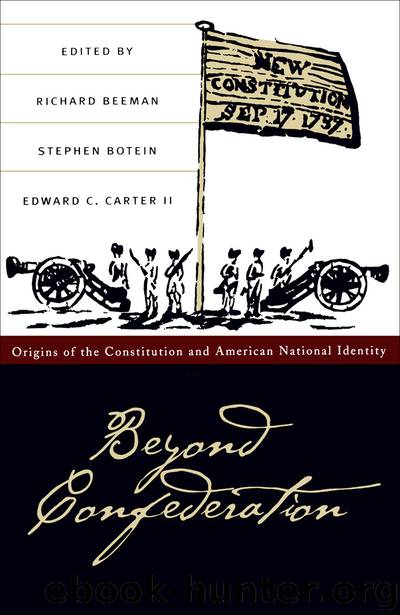Beyond Confederation by Richard Beeman & Stephen Botein & Edward C. Carter II

Author:Richard Beeman & Stephen Botein & Edward C. Carter II
Language: eng
Format: epub
Publisher: The University of North Carolina Press
Published: 1987-03-19T16:00:00+00:00
Slavery and the Constitutional Convention
Making a Covenant with Death
PAUL FINKELMAN
For the nineteenth-century abolitionist William Lloyd Garrison, the Constitution was the result of a terrible bargain between freedom and slavery. The American states were, in Garrison’s words, united by a “covenant with death” and “agreement with Hell.” Garrison and his followers refused to participate in American electoral politics, because to do so they would have had to support this “covenant with death.” Instead, under the slogan “No Union with Slaveholders,” the Garrisonian abolitionists repeatedly called for an end to the nation. Their disunion sentiments were based in part on the moral principle of avoiding the corruption of the proslavery Constitution. But their position was also pragmatic. Convinced that the legal protection of slavery in the Constitution made political activity futile, the Garrisonians thought only moral suasion could save America from its “covenant with death.”1
The Garrisonians did not necessarily see the Constitution as the result of a deliberate conspiracy of evil men; rather, they understood it to be the consequence of political give-and-take at the Convention of 1787. Thus, in his aptly titled pamphlet The Constitution: A Pro-Slavery Compact, Wendell Phillips analyzed “that ‘compromise,’ which was made between slavery and freedom, in 1787; granting to the slaveholder distinct privileges and protection for his slave property, in return for certain commercial concessions on his part toward the North.” Phillips further argued that “the Nation at large were fully aware of this bargain at the time, and entered into it willingly and with open eyes.”2 Phillips’s argument both exaggerated and understated the nature of the relationship between slavery and the Constitution. Certainly, some of those at the convention “entered into” the bargain with great reservations, and many at the ratifying conventions may indeed have had their eyes at least partially closed to the full extent of the “bargain.” On the other hand, the bargain involved more than commerce and slavery; it concerned the very creation of the Union itself.
Other nineteenth-century antislavery thinkers disagreed with the Garrisonians. Salmon P. Chase, the most successful antislavery politician, fought a lifelong battle to convince his colleagues, and numerous jurists, that the Constitution was really opposed to slavery. Despite his creative attempts, Chase’s efforts always failed.3 The United States Supreme Court almost always protected slavery in the cases it heard.4 Likewise, almost all American presidents and their cabinet officers protected slavery in foreign and domestic politics. Perhaps most frustrating to the political abolitionists was the fact that some of their most brilliant allies in the crusade against slavery—the Garrisonians—agreed with their enemies on the meaning of the Constitution. Thus, one Ohio Liberty Party man ruefully noted after reading Wendell Phillips’s pamphlet on the Constitution: “Garrison, Phillips, and Quincy; Calhoun, Rhett, and McDuffie; all harmoniously laboring to prevent such a construction of the Constitution as would abolish slavery.”5
A careful reading of the Constitution reveals that the Garrisonians were right to believe that the national compact favored slavery. And a detailed examination of the Convention of 1787 explains how the Constitution evolved in this way.
Download
This site does not store any files on its server. We only index and link to content provided by other sites. Please contact the content providers to delete copyright contents if any and email us, we'll remove relevant links or contents immediately.
| Anthropology | Archaeology |
| Philosophy | Politics & Government |
| Social Sciences | Sociology |
| Women's Studies |
Cecilia; Or, Memoirs of an Heiress — Volume 1 by Fanny Burney(32434)
Cecilia; Or, Memoirs of an Heiress — Volume 2 by Fanny Burney(31871)
Cecilia; Or, Memoirs of an Heiress — Volume 3 by Fanny Burney(31852)
The Great Music City by Andrea Baker(31348)
We're Going to Need More Wine by Gabrielle Union(18967)
All the Missing Girls by Megan Miranda(15567)
Pimp by Iceberg Slim(14393)
Bombshells: Glamour Girls of a Lifetime by Sullivan Steve(13972)
Talking to Strangers by Malcolm Gladwell(13222)
Norse Mythology by Gaiman Neil(13204)
Fifty Shades Freed by E L James(13157)
For the Love of Europe by Rick Steves(12977)
Mindhunter: Inside the FBI's Elite Serial Crime Unit by John E. Douglas & Mark Olshaker(9200)
Crazy Rich Asians by Kevin Kwan(9167)
The Lost Art of Listening by Michael P. Nichols(7406)
Enlightenment Now: The Case for Reason, Science, Humanism, and Progress by Steven Pinker(7228)
The Four Agreements by Don Miguel Ruiz(6630)
Bad Blood by John Carreyrou(6552)
Weapons of Math Destruction by Cathy O'Neil(6143)
